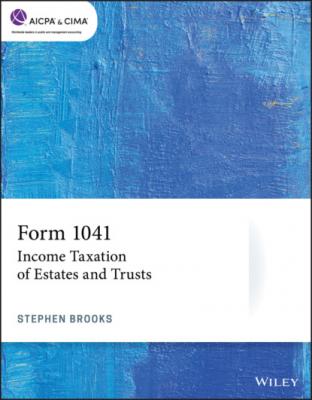Form 1041. Stephen Brooks
Читать онлайн.| Название | Form 1041 |
|---|---|
| Автор произведения | Stephen Brooks |
| Жанр | Личные финансы |
| Серия | |
| Издательство | Личные финансы |
| Год выпуска | 0 |
| isbn | 9781119763956 |
Finally, the UPIA deals with guidance in regard to the exercise of fiduciary investment decisions. The UPIA has been adopted in 44 states and the District of Columbia. Other states have adopted parts of the act, but not the entire act. The approach under UPIA allows fiduciaries to use modern portfolio theory to guide investment decisions and requires risk versus return analysis. As a result, a fiduciary's investment performance is evaluated based on the performance of the entire portfolio, rather than individual investments.
Situs
Where a trust has situs determines the jurisdiction of the courts regarding matters involving a trust.37 Situs is generally established by a provision in the trust instrument provided either
the trustee's principal place of business is located in or a trustee is a resident of the designated jurisdiction;
all or part of the trust administration occurs in the designated jurisdiction; or
one or more of the beneficiaries resides in the designated jurisdiction.38
Absent a trust provision, establishing situs in a particular jurisdiction will depend on such factors as whether the trust was a testamentary or inter vivos trust, where the trustee has its principal place of business, and where all or part of the trust administration occurs.39
The term of a trust
The trust agreement may provide for a specific term of the trust. For example, a trust agreement may provide that the trust will end after a specified period of time has elapsed, such as 20 years after the formation of the trust. The trust agreement may also state that the trust will end upon the occurrence of a specified event, for instance, the beneficiary reaching the age of 21. In addition, the settlor may retain the power to revoke the trust or vest that power in the trustee or other named party, even the trust beneficiaries. Generally, a settlor may revoke or amend a trust unless the trust instrument expressly provides that the trust is irrevocable.40 The UTC also contains provisions which permit termination and modification of a trust with or without court approval.41 Absent specific provisions in the trust document, a trust will terminate when no purpose of the trust remains to be achieved, or the purposes of the trust have become unlawful or contrary to public policy.42
Rule against perpetuities
Under the law of many states, a trust must terminate under what is known as the rule against perpetuities. This rule originated as a part of the law, which first developed the legal concept of what a trust is and how it is to be administered. Under the rule, a trust must end no later than the death of the last trust beneficiary living upon the creation of the trust plus 21 years. Some states have specifically revoked the rule, and in those states, a trust can theoretically last forever (in perpetuity).
At the time that this course was written, the following 29 states and the District of Columbia allow for trusts to continue well past the previously listed limitations and in most cases, continue into perpetuity.
Alaska
Arizona
Arkansas
Colorado
Delaware
District of Columbia
Florida
Hawaii
Idaho
Illinois
Kentucky
Maine
Maryland
Michigan
Missouri
Nebraska
Nevada
New Hampshire
New Jersey
North Carolina
Ohio
Pennsylvania
Rhode Island
South Dakota
Tennessee
Utah
Virginia
Washington
Wisconsin
Wyoming
Term for tax purposes
For tax purposes, the determination of whether a trust has terminated depends upon whether the property held in trust has been distributed to the persons entitled to succeed to the property upon termination of the trust rather than upon the technicality of whether or not the trustee has rendered his final accounting.
A trust does not automatically terminate upon the happening of the event by which the duration of the trust is measured. A reasonable time is permitted after such event for the trustee to perform the duties necessary to complete the administration of the trust. Thus, if under the terms of the governing instrument, the trust is to terminate upon the death of the life beneficiary and the corpus is to be distributed to the remainderman, the trust continues after the death of the life beneficiary for a period reasonably necessary to a proper winding up of the affairs of the trust.
However, the winding up of a trust cannot be unduly postponed, and if the distribution of the trust corpus is unreasonably delayed, the trust is considered terminated for federal income tax purposes after the expiration of a reasonable period for the trustee to complete the administration of the trust. Further, a trust will be considered as terminated when all the assets have been distributed except for a reasonable amount which is set aside in good faith for the payment of unascertained or contingent liabilities and expenses (not including a claim by a beneficiary in the capacity of beneficiary).43
The trust agreement
In most cases, the terms of the trust are governed by a written trust agreement. To reiterate, oral trusts are also recognized in some situations; however, in most states that have adopted the Uniform Trust Act, an oral trust is only recognized if there is clear and convincing evidence a trust was created.44 The specific terms under which the trustee deals with the investment of the trust corpus and distribution or retention of the trust income and principal to the trust beneficiaries is generally stated in the trust agreement. The trust can either be established during the lifetime of the settlor of the trust (an inter vivos trust) or under the settlor's will (a testamentary trust).
A typical trust agreement will contain the following seven trust provisions:
The declaration of trust — This is the provision that meets the requirement
